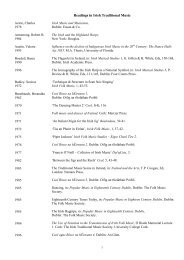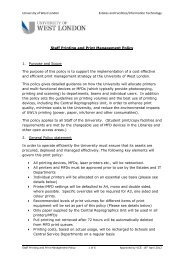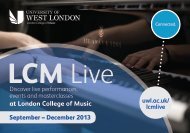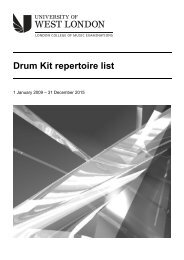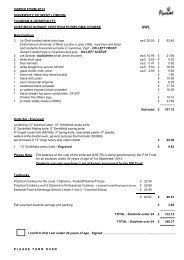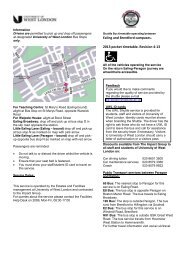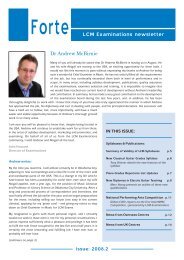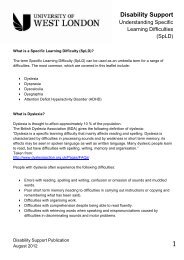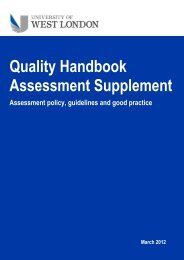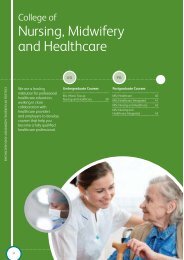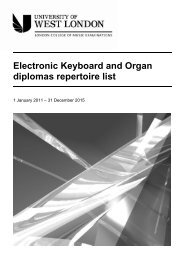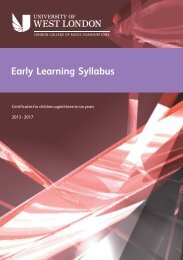LCM Exams - Jazz Diplomas Syllabus - University of West London
LCM Exams - Jazz Diplomas Syllabus - University of West London
LCM Exams - Jazz Diplomas Syllabus - University of West London
Create successful ePaper yourself
Turn your PDF publications into a flip-book with our unique Google optimized e-Paper software.
2.4.6 <strong>Jazz</strong> Wind & Brass: A<strong>LCM</strong><br />
Component 1: Technical work<br />
10 marks<br />
The technical work should be prepared from memory, slurred, legato tongued, staccato tongued and swung.<br />
Candidates are encouraged to <strong>of</strong>fer the scales and arpeggios in octaves rather than twelfths.<br />
eg. Clarinet: starting on E, F, F# and G the range will be 3 octaves; all others 2 octaves.<br />
Flute: all 2 octaves except those starting on C, which will be 3 octaves.<br />
Trumpet: range to high C.<br />
Saxophone: B♭ to F, all 2 octaves. Others may be 1 octave, or 2 octaves if the<br />
candidate wishes to use the altissimo register.<br />
1. All major and minor scales (harmonic or melodic or pure – candidate’s choice) and arpeggios, within the<br />
compass <strong>of</strong> the instrument.<br />
2. Chromatic scale, starting on any note.<br />
3. Whole tone scales on C or C#.<br />
4. Dominant 7ths in all keys resolving on the tonic.<br />
eg. Dominant 7th <strong>of</strong> F:<br />
<br />
<br />
b b <br />
5. Diminished 7ths on C, C# and D.<br />
6. Dorian or Mixolydian modes (candidate’s choice), starting on any note.<br />
7. Blues scales, starting on any note.<br />
For further information please refer to ‘Scales for <strong>Jazz</strong> Improvisation’ by Dan Haerle (see Section 3.3).<br />
Component 2: Solo transcription<br />
20 marks<br />
Candidates should perform ONE transcription, <strong>of</strong> their own choice. The performance should include the Head<br />
(if applicable), as well as the transcribed solo.<br />
Candidates may wish to make their own transcription from a recording. (A copy <strong>of</strong> the recording must be<br />
available for the examiners.)<br />
A rhythm section or accompanist (piano / keyboard / guitar) may be added to help authenticity. Candidates<br />
may wish to use a backing track as an alternative to support players. Provision <strong>of</strong> sound equipment is the<br />
responsibility <strong>of</strong> the candidate. Refer to the guidance on setting up in Section 2.1.<br />
Component 3: Improvisations<br />
45 marks<br />
Candidates should introduce and present a ‘set’ <strong>of</strong> approximately 20 minutes’ duration. At least two<br />
contrasting styles should be represented. Each piece should be introduced, as at a gig. As a guide, four pieces<br />
might <strong>of</strong>fer a balanced programme. Candidates should feel free to explore any style, ranging from blues and<br />
New Orleans to the contemporary.<br />
One piece may be performed on a second instrument. Saxophonists and clarinettists may use more than one<br />
type <strong>of</strong> instrument. Trumpet players may also use the cornet or flugelhorn. The candidate may also <strong>of</strong>fer a<br />
vocal chorus on one number (in the tradition <strong>of</strong> artists such as Curtis Stigers, Louis Armstrong and Jack<br />
Teagarden). Candidates are encouraged to fully exploit their creative instincts. Own compositions are<br />
encouraged.<br />
The use <strong>of</strong> a rhythm section or accompanist (eg. piano / guitar) is welcome. Backing tracks may also be used,<br />
including self-produced tracks. Refer to the guidance on setting up in Section 2.1.<br />
19




